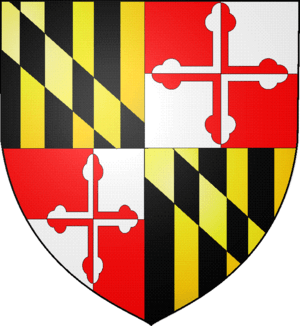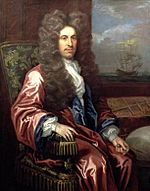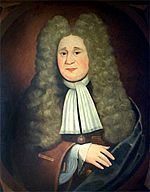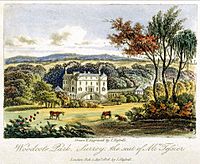Charles Calvert, 3rd Baron Baltimore facts for kids
Quick facts for kids
The Lord Baltimore
|
|
|---|---|
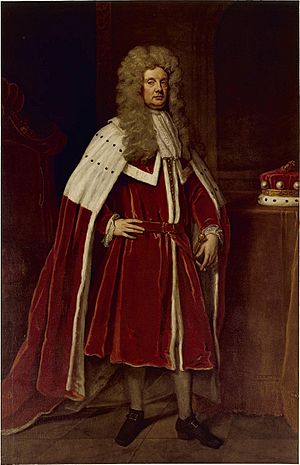
Portrait of Charles Calvert, 3rd Baron Baltimore by Sir Godfrey Kneller
|
|
| 6th and 9th Proprietary-Governor of Maryland | |
| In office 1661–1676 |
|
| Preceded by | Phillip Calvert |
| Succeeded by | Jesse Wharton |
| In office 1679–1684 |
|
| Preceded by | Thomas Notley |
| Succeeded by | Benedict Calvert, 4th Baron Baltimore, (1679-1715) |
| Personal details | |
| Born | August 27, 1637 Salisbury, England |
| Died | February 21, 1715 (aged 77) St Pancras, London, England |
| Spouses | Mary Darnall Jane Lowe Mary Bankes Margaret Charleton |
| Children | Benedict Calvert, 4th Baron Baltimore Capt. Charles Calvert (illegitimate) Mary Calvert |
| Parents | Cecilius Calvert, 2nd Baron Baltimore Anne Arundell |
| Signature | |
Charles Calvert, 3rd Baron Baltimore (born August 27, 1637 – died February 21, 1715) was an important leader in the early American colony of Maryland. He became the owner of Maryland in 1675 after his father, Cecil Calvert, 2nd Baron Baltimore, passed away. Charles had already been helping his father govern the colony since 1661. He was 24 years old when he first arrived in Maryland.
However, Charles left Maryland for England in 1684 and never came back. Big changes in England, known as the Glorious Revolution in 1688, caused him to lose control of Maryland. In 1689, the king took back the colony's charter, meaning the British Crown ruled Maryland directly. Charles Calvert faced many problems because he was a Roman Catholic, which was different from the official Church of England. He married four times and had at least two children. He died in England in 1715 when he was 78. His family's wealth had become much smaller.
After his death, his title and claim to Maryland went to his second son, Benedict Calvert, 4th Baron Baltimore (1679–1715). His oldest son, Cecil, had died young. Sadly, Benedict Calvert died just two months after his father. So, it was Charles' grandson, Charles Calvert, 5th Baron Baltimore (1699–1751), who finally saw the family get back control of the Province of Maryland. This grandson changed his religion to Anglicanism to make this happen.
Contents
- Charles Calvert: Early Life and Family
- Governing Maryland: A Colony's Challenges
- Maryland's Unique Beginning
- Charles Arrives in Maryland
- Economic Challenges for the Colony
- Religion and Power in Maryland
- Slavery in Maryland
- Religious Conflicts and Challenges
- Conspiracies and Border Disputes
- Leaving Maryland for England
- The Glorious Revolution and Maryland
- The Protestant Revolution in Maryland
- Later Life and Legacy
- Images for kids
Charles Calvert: Early Life and Family
Charles was born in England on August 27, 1637. He grew up during the English Civil War, a time of big religious fights. His father, Cecil Calvert, 2nd Baron Baltimore, was the first owner and governor of Maryland. He also owned Newfoundland.
Charles' mother was Anne Arundell. She was the daughter of the 1st Baron Arundell of Wardour. Anne and Cecil married around 1627 or 1628 and had nine children. But only two of Charles' brothers and sisters lived to be adults. His mother, Anne, died in 1649 when Charles was only 12 years old.
Governing Maryland: A Colony's Challenges
Maryland's Unique Beginning

The Calvert family were Roman Catholics. They started Maryland as a special colony where Catholics, different kinds of Protestants, and members of the Church of England could all live together peacefully. Cecil Calvert, 2nd Baron Baltimore, received the right to own Maryland. This right was meant for his father, George Calvert, 1st Baron Baltimore, who died in 1632.
Cecil managed Maryland from England. He sent his younger brother, Leonard Calvert, to be the first governor of the colony. As a Catholic, Cecil continued his father's idea of religious tolerance. He governed Maryland for 42 years, but he never actually visited the colony himself.
In 1649, the Maryland General Assembly, which was the colony's law-making group, passed the Maryland Toleration Act. This law said that all Christians who believed in the Trinity (God as Father, Son, and Holy Spirit) should be tolerated. It was the first law of its kind in the British colonies in North America. The Calvert family wanted this law to protect Catholics and other Christians who were not part of the Church of England. This religious tolerance lasted for about 40 years. It ended during the Protestant Revolution of 1689. After that, Maryland officially became Anglican until 1776.
Charles Arrives in Maryland
Charles Calvert sailed to Maryland in 1661 when he was 24. He was the first Lord Baltimore to actually live in and manage the colony. His father made him deputy governor. When Cecil Calvert died in 1675, Charles inherited Maryland and became governor.
Before 1666, he married Mary Darnall. She was from a rich Catholic family in Maryland. Sadly, Mary died during childbirth. In 1667, Charles married again to Jane Lowe. She was a widow. In late 1667 or early 1668, they had a son named Cecil Calvert.
Economic Challenges for the Colony
Charles Calvert's time as governor was difficult because of money problems. Starting in the 1660s, the price of tobacco began to fall. Tobacco was Maryland's main crop and its biggest source of income. This caused hardship, especially for poorer people.
In 1666, Virginia, a neighboring colony, suggested stopping tobacco growing for one year. This "stint" would reduce the supply and hopefully raise prices. Calvert first agreed but then realized it would hurt his poorest people the most. He decided not to approve the plan. This made the Virginians upset. However, a hurricane in 1667 destroyed the tobacco crop, which ended up being a "stint" by nature.
Religion and Power in Maryland
By the time Charles Calvert became governor, most people in Maryland were Protestant. However, political power stayed mostly with the Catholic leaders. Even with more Protestants, Calvert tried to keep Maryland's Catholic identity.
From 1669 to 1689, out of 27 men on the Governor's Council, only 8 were Protestant. Most council members were Catholic. Many were related to the Calvert family. They often held important jobs, like leading the militia.
There were many arguments between Calvert and the colonists. People argued about how much English law should apply in Maryland. They also argued about how much power the governor had outside of the law. Calvert wanted to protect his power. He said only he and his council could decide when English law applied. This made some people worry about unfair rule.
Calvert took steps to limit the power of the Protestant majority. In 1670, he allowed only men who owned 50 acres (about 200,000 square meters) of land or property worth more than 40 pounds to vote. He also said that only people who owned at least 1,000 acres (about 4 square kilometers) could be elected to Maryland's House of Delegates. In 1676, he reduced the number of delegates voters could choose from four to two. These actions made the assembly easier to control but also caused tension.
Slavery in Maryland
One of Charles Calvert's early decisions had long-lasting and sad effects. This decision was about the legal status of Africans brought to Maryland. The first Africans arrived in Maryland in 1642. Their legal status was not clear at first. Courts sometimes ruled that enslaved people who became Christian should be freed.
To protect the rights of slave owners, new laws were passed. In 1663, the Assembly ruled that enslaved people would be enslaved for life. It also said that the children of enslaved people would also be enslaved for life. This continued slavery for 200 years until it was ended during the American Civil War. However, the full impact of these harsh laws was not felt right away. Large numbers of Africans were not brought to Maryland until the 1690s.
Religious Conflicts and Challenges
In 1675, Charles' father, the second Lord Baltimore, died. Charles, who was 38, went to London to become the new Baron. While he was away, his political enemies attacked his government. They published a paper in 1676 called "A Complaint from Heaven." It listed many complaints, especially about the lack of an official church.
The Church of England was also unhappy with Maryland's religious tolerance. An Anglican priest, Rev. John Yeo, wrote to the Archbishop of Canterbury. He complained that Maryland was in a "deplorable condition." This was taken seriously in London. The Privy Council asked Calvert to respond to the complaints.
Calvert's answer was strong. He said that Maryland settlers included many different groups. These included Presbyterians, Independents, Anabaptists, and Quakers. He said that members of the Church of England and Catholics were the fewest. He explained that it would be very hard to make these people pay for ministers of a different faith.
Conspiracies and Border Disputes
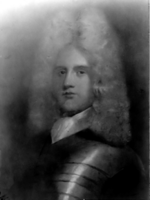
In 1679, Charles and Jane had another son, Benedict. But two years later, in 1681, Lord Baltimore faced another rebellion. It was led by a former governor, Josias Fendall, and John Coode. Fendall was punished and sent away. Coode escaped.
At this time, Maryland was becoming very unstable. The governor of Virginia said that "Maryland is now in torment." Relations between the governing council and the assembly got worse. A big reason for this was the continuing drop in tobacco prices. By the 1680s, prices had fallen by 50% in 30 years. In 1681, Charles also faced a personal sadness. His oldest son and heir, Cecil, died. This made his second son, Benedict, the next in line to inherit.
Calvert also had a serious argument with William Penn over land boundaries. Penn was the founder of Pennsylvania. In 1681, King Charles II gave Penn a large area of land north of Maryland. But Penn started building his main city south of the 40th Parallel, which was in Maryland territory. Penn and Calvert met twice but could not agree. This border dispute lasted long after both Calvert and Penn died, finally being solved in 1769.
Leaving Maryland for England
In 1684, Charles Calvert went to England. He needed to defend himself in the land dispute with Penn. He also had to answer charges that he favored Catholics in Maryland. He never returned to Maryland.
Calvert left his nephew, George Talbot, in charge as acting governor. Unfortunately, Talbot was not a good choice. He killed a royal customs official. This caused problems for Calvert when he returned to London. Calvert replaced Talbot with another Catholic, William Joseph. Joseph also caused trouble. In November 1688, he upset people by talking about morality and the divine right of kings.
The Glorious Revolution and Maryland
In England, big changes were happening. In 1688, the country had the Glorious Revolution. The Catholic King James II of England was removed from power. The Protestant rulers King William and Mary II of England took the throne. This change caused many problems for Calvert.
Calvert quickly tried to support the new rulers. He sent a messenger to Maryland to announce the new King and Queen. But the messenger died on the way. A second messenger (if one was sent) never arrived.
The Protestant Revolution in Maryland
Meanwhile, Protestants in Maryland, who were now the majority, heard rumors from England. They feared Catholic plots and began to plan a rebellion against the proprietary government. Governor Joseph made things worse by not calling the assembly. He also took weapons from storage, saying they needed repair.
Protestants were angry that the new King and Queen were not officially supported. They were also upset that Catholics like deputy governor Colonel Henry Darnall held powerful positions. So, they began to arm themselves. In the summer of 1689, an army of 700 Protestants, led by Colonel John Coode, defeated the proprietary army led by Colonel Darnall. Darnall's army was greatly outnumbered. He later wrote that they surrendered to prevent bloodshed.
After this "Protestant Revolution" in Maryland, Coode and his Protestant allies set up a new government. They made Catholicism illegal. Catholics had to hold secret services in their homes. In 1704, a law was passed to "prevent the growth of Popery." This law stopped Catholics from holding political office. Full religious tolerance did not return to Maryland until the American Revolution. In 1776, Charles Carroll of Carrollton, a wealthy Catholic and Darnall's great-grandson, signed the American Declaration of Independence.
John Coode stayed in power until a new royal governor, Nehemiah Blakiston, was appointed in 1691. Charles Calvert never returned to Maryland. Even worse, his family's royal charter to the colony was taken away in 1689.
Later Life and Legacy
Charles Calvert's problems did not end when he lost Maryland. In 1694, he was linked to a plot, but he avoided arrest. In 1696, his luck improved. He became a brigadier general and then a major-general in 1704.
Calvert's second wife, Jane, died around 1693 or 1694. He married a third time to Mary Bankes between 1701 and 1710. His fourth and final marriage was to Margaret Charleton in 1712.
Calvert lived at his family's estate, Woodcote Park, in Surrey, England. In 1712, a writer named Celia Fiennes described Woodcote as an old but large house with big courtyards.
Family and the Future of Maryland
Charles Calvert remained a Roman Catholic, even though it caused him political problems. But his oldest living son, Benedict Calvert, 4th Baron Baltimore (1679–1715), changed his religion. Benedict believed that being Catholic was the main reason his family had lost Maryland. So, he became an Anglican. He hoped this would help his family get back their lost wealth and power in the New World.
This was a big step. Lord Baltimore, Charles, was furious about his son's conversion. He stopped giving Benedict money and stopped supporting his grandchildren's education. However, Charles Calvert died in 1715. His title and claim to Maryland then passed to his son Benedict. Benedict is buried in the churchyard of St Pancras Old Church in London.
Upon his father's death, Charles' son Benedict asked King George I to give his family back the right to own Maryland. Sadly, Benedict died just two months after his father, before the king could decide. So, the title passed to Benedict's son, Charles. On May 15, 1715, Charles Calvert, 5th Baron Baltimore, who was only 16, was lucky. The King restored his family's right to own Maryland. In 1721, he became an adult and took control of the Colony. The Calvert family continued to control Maryland until 1776, when the American Revolution began.
Charles County, Maryland was named after Charles Calvert.
A very large portrait of Charles Calvert, along with other Lords Baltimore, hangs in the Great Hall of the Enoch Pratt Free Library in downtown Baltimore. The city of Baltimore is named after his family.
Images for kids
-
Captain Charles Calvert, likely a child of the 3rd Baron Baltimore


